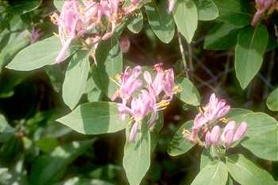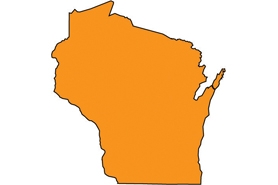Tatarian honeysuckle
(Lonicera tatarica)
Dense, multi-stemmed shrubs, deciduous shrubs 6-12’ tall. Young stems are slightly hairy and light brown while older branches may have shaggy, peeling bark and are often hollow between the nodes.
Other names for this plant include:
- Common names: Tartarian honeysuckle, bush honeysuckle
- Scientific names: Lonicera sibirica; L. tatarica var. latifolia
Classification in Wisconsin: Restricted
- Ecological Threat
-
- Invade various habitats, including forest edges, open woods, fens, bogs, lakeshores, roadsides, pastures and old fields.
- Tartarian honeysuckles alter habitats by decreasing light availability, depleting soil moisture and nutrients, and possibly releasing allelopathic chemicals that inhibit the growth of other plants.
- Eurasian bush honeysuckles have been widely planted as ornamentals and for wildlife habitats. Commercial propagation continues with many cultivars available from nurseries.
- Hybrizes with L. morrowii to create L. x bella which is also invasive
- Identification
-
Leaves: Opposite, oval or oblong and untoothed. Leaves may be hairless to downy and green or blue-green. Leaf bases are slightly heart-shaped to nearly straight. Leaves come on 1 to 2 weeks earlier in spring and stay on later in fall than the leaves of native trees and shrubs.
Flowers: Fragrant, tubular and arranged in pairs at leaf axils. Reddish pink or white, turning yellow with age. Bloom mid-to-late spring.
Fruits & seeds: Red to orange berries occur in pairs at leaf axils and contain many seeds. Birds readily disperse them.
Roots: Fibrous and shallow.
Similar species: Native Lonicera shrubs have shorter, sparser growth forms and white pith in stems. Native Diervilla species have yellow flowers that turn red with age and fruits that are elongated capsules and grow in dry or rocky sites. Native species develop leaves 1-2 weeks later, drop them earlier in the fall, and often have solid stems. L. morrowii, L. x bella and L. maackii are invasive bush honeysuckles. They are all very similar except for slight differences in flower color and leaf downiness.
- Control
-
Mechanical: Small to medium-sized plants can be dug or pulled by hand or leverage tool. Prescribed burns in spring kill seedlings and top kills older plants.
Chemical: Cut-stump treatment with glyphosate or basal bark around each plant stems with triclopyr ester. Treat foliage with glyphosate in early spring before leaf out of native species.
For more information on control techniques, visit the Bush honeysuckles factsheet [exit DNR] by the University of Wisconsin-Extension.
- Resources
- Sources for content:
- Czarapata, Elizabeth; Invasive Plants of the Upper Midwest: an illustrated guide to their identification and control. The University of Wisconsin Press. 2005. Pg. 32-33
- Center for Invasive Species and Ecosystem Health: Invasive.org. Tatarian honeysuckle.
- Invasive Plant Atlas of New England. Tartarian honeysuckle [exit DNR] (Lonicera tatarica).


